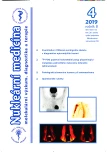18F-FDG positive colorectal polyp mimicing metastasis of advanced melanoma treated with ipilimumab
Authors:
R. Koukalová 1; R. Lakomý 2; P. Fabian 3; Z. Řehák 1,4; P. Szturz 5
Authors‘ workplace:
Oddělení nukleární medicíny, 2 Klinika komplexní onkologické péče, 3 Oddělení onkologické patologie
1; Regionální centrum aplikované molekulární onkologie, Masarykův onkologický ústav, Brno, ČR
4; Department of Oncology, Lausanne University Hospital (CHUV), Lausanne, Switzerland
5
Published in:
NuklMed 2019;8:76-79
Category:
Casuistry
Overview
Given its high diagnostic accuracy, 18F-fluorodeoxyglucose positron emission tomography/computed tomography (18F-FDG PET/CT) has often been used as initial staging and follow-up imaging in patients with malignant melanoma. In the majority of cases, the primary tumour and its metastases show high metabolic activity, and even small subclinical lesions can thus be detected by 18F-FDG PET/CT scanning. In 2010, an important step forward was made in the treatment of malignant melanoma – the era of modern immunotherapy began, and ipilimumab represented one of the first effective drugs. Herein, we present a case of a women with recurrent, metastatic melanoma with persistent increased 18F-FDG accumulation in the abdominal cavity. The lesion could not be identified on exploratory laparotomy and remained unchanged during ipilimumab treatment. Surprisingly, repeated PET/CT examination localized the FDG uptake to an asymptomatic colon polyp histologically corresponding to adenocarcinoma in situ arising in villous adenoma.
Keywords:
PET/CT – immunotherapy – ipilimumab – colorectal polyp – carcinoma in situ
Sources
- Hodi FS, O‘Day SJ, McDermott DF, et al. Improved survival with ipilimumab in patients with metastatic melanoma. N Engl J Med. 2010;363:711-723
- Schadendorf D, Hodi FS, Robert C, et al. Pooled Analysis of Long-Term Survival Data From Phase II and Phase III Trials of Ipilimumab in Unresectable or Metastatic Melanoma. J Clin Oncol 2015;33:1889-94 doi: 10.1200/JCO.2014.56.2736.
- Schröer-Günther MA, Wolff RF, Westwood ME, et al. F-18-fluoro-2-deoxyglucose positron emission tomography (PET) and PET/computed tomography imaging in primary staging of patients with malignant melanoma: a systematic review. Syst Rev 2012;1:62
- Treglia G, Taralli S, Salsano M, et al. Prevalence and malignancy risk of focal colorectal incidental uptake detected by (18)F-FDG-PET or PET/CT: a meta-analysis. Radiol Oncol 2014;48:99-104
- Putora PM, Müller J, Borovicka J, et al. Relevance of incidental colorectal FDG-PET/CT-enhanced lesions. Onkologie 2013;36:200-204
- Soltau SR, Hess S, Nguyen T, et al. Clinical significance of incidental focal bowel uptake on 18F-FDG PET/CT as related to colorectal cancer. Hell J Nucl Med 2016;19:245-249
- Abdel-Nabi H, Doerr RJ, Lamonica DM, et al. Staging of primary colorectal carcinomas with fluorine-18 fluorodeoxyglucose whole-body PET: correlation with histopathologic and CT findings. Radiology 1998;206:755-760
- Řehák Z, Lakomý R, Fait V. Onkologie v obrazech. Rozmanitost 18F-FDG obrazů pacientů s maligním melanomem. Klinická onkologie 2015; 28:143-144
Labels
Nuclear medicine Radiodiagnostics RadiotherapyArticle was published in
Nuclear Medicine

2019 Issue 4
Most read in this issue
- Contribution of three-phase elbow scintigraphy to the asessment of epicondylitis and to the decision about recognition as an occupational disease
- Quantitative three-phase bone scintigraphy in the diagnosis of epicondylitis humeri
- 18F-FDG positive colorectal polyp mimicing metastasis of advanced melanoma treated with ipilimumab
- Patological fracture of humerus in osteosarcoma – a case report
